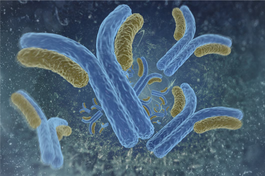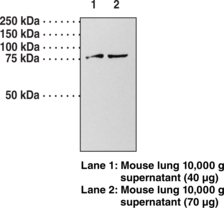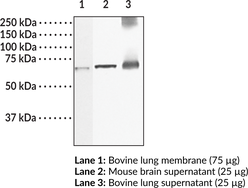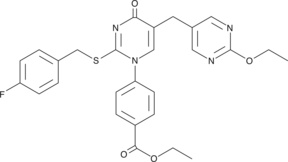Cayman
Showing 23101–23250 of 45550 results
-
GSK591 is a chemical probe for protein arginine methyltransferase 5 (PRMT5) that potently inhibits the PRMT5/MEP50 complex from methylating histone H4 (IC50 = 11 nM) in vitro. GSK591 is selective for PRMT5 (up to 50 µM) relative to a panel of other methyltransferases. In Z-138 cells, GSK591 inhibits the symmetric arginine methylation of SmD3 with an EC50 value of 56 nM. For more information on GSK591 please visit the Structural Genomics Consortium (SGC). The negative control, SGC2096, for GSK591 is also available exclusively through the SGC. You can submit a request to receive the negative control here.
Brand:CaymanSKU:-Available on backorder
-
GSK591 is a chemical probe for protein arginine methyltransferase 5 (PRMT5) that potently inhibits the PRMT5/MEP50 complex from methylating histone H4 (IC50 = 11 nM) in vitro. GSK591 is selective for PRMT5 (up to 50 µM) relative to a panel of other methyltransferases. In Z-138 cells, GSK591 inhibits the symmetric arginine methylation of SmD3 with an EC50 value of 56 nM. For more information on GSK591 please visit the Structural Genomics Consortium (SGC). The negative control, SGC2096, for GSK591 is also available exclusively through the SGC. You can submit a request to receive the negative control here.
Brand:CaymanSKU:-Available on backorder
-
The bromodomain and PHD finger-containing (BRPF) proteins are scaffolding components of chromatin-binding MOZ/MORF histone acetyltransferase complexes, which have activity as transcriptional regulators.{21051,29177} BRPF1 (BR140 or Peregrin) is important for maintaining Hox gene expression and the development of multiple tissues, axial skeleton, and the hematopoietic system.{29177} GSK5959 is a potent, cell-permeable inhibitor of the BRPF1 bromodomain (IC50 = 80 nM).{29176} It exhibits greater than 100-fold selectivity for the BRPF1 bromodomain over a panel of 35 other bromodomains. GSK5959 disrupts chromatin binding of BRPF1 in a cellular assay by blocking the interaction of BRPF1 with histone H3.3.{29176}
Brand:CaymanSKU:-Available on backorder
-
The bromodomain and PHD finger-containing (BRPF) proteins are scaffolding components of chromatin-binding MOZ/MORF histone acetyltransferase complexes, which have activity as transcriptional regulators.{21051,29177} BRPF1 (BR140 or Peregrin) is important for maintaining Hox gene expression and the development of multiple tissues, axial skeleton, and the hematopoietic system.{29177} GSK5959 is a potent, cell-permeable inhibitor of the BRPF1 bromodomain (IC50 = 80 nM).{29176} It exhibits greater than 100-fold selectivity for the BRPF1 bromodomain over a panel of 35 other bromodomains. GSK5959 disrupts chromatin binding of BRPF1 in a cellular assay by blocking the interaction of BRPF1 with histone H3.3.{29176}
Brand:CaymanSKU:-Available on backorder
-
The bromodomain and PHD finger-containing (BRPF) proteins are scaffolding components of chromatin-binding MOZ/MORF histone acetyltransferase complexes, which have activity as transcriptional regulators.{21051,29177} BRPF1 (BR140 or Peregrin) is important for maintaining Hox gene expression and the development of multiple tissues, axial skeleton, and the hematopoietic system.{29177} GSK5959 is a potent, cell-permeable inhibitor of the BRPF1 bromodomain (IC50 = 80 nM).{29176} It exhibits greater than 100-fold selectivity for the BRPF1 bromodomain over a panel of 35 other bromodomains. GSK5959 disrupts chromatin binding of BRPF1 in a cellular assay by blocking the interaction of BRPF1 with histone H3.3.{29176}
Brand:CaymanSKU:-Available on backorder
-
The bromodomain and PHD finger-containing (BRPF) proteins are scaffolding components of chromatin-binding MOZ/MORF histone acetyltransferase complexes, which have activity as transcriptional regulators.{21051,29177} BRPF1 (BR140 or Peregrin) is important for maintaining Hox gene expression and the development of multiple tissues, axial skeleton, and the hematopoietic system.{29177} GSK5959 is a potent, cell-permeable inhibitor of the BRPF1 bromodomain (IC50 = 80 nM).{29176} It exhibits greater than 100-fold selectivity for the BRPF1 bromodomain over a panel of 35 other bromodomains. GSK5959 disrupts chromatin binding of BRPF1 in a cellular assay by blocking the interaction of BRPF1 with histone H3.3.{29176}
Brand:CaymanSKU:-Available on backorder
-
GSK621 is an activator of AMP-activated protein kinase (AMPK). It has been shown to increase phosphorylation at AMPKα T172, a marker of AMPK activation, in both acute myeloid leukemia (AML) cell lines and primary AML samples.{31816} GSK621 is reported to reduce the proliferation of AML cell lines (IC50s = 13-30 μM), triggering autophagy via the eIF2α/ATF4 signaling pathway.{31816}
Brand:CaymanSKU:-Available on backorder
-
GSK621 is an activator of AMP-activated protein kinase (AMPK). It has been shown to increase phosphorylation at AMPKα T172, a marker of AMPK activation, in both acute myeloid leukemia (AML) cell lines and primary AML samples.{31816} GSK621 is reported to reduce the proliferation of AML cell lines (IC50s = 13-30 μM), triggering autophagy via the eIF2α/ATF4 signaling pathway.{31816}
Brand:CaymanSKU:-Available on backorder
-
GSK621 is an activator of AMP-activated protein kinase (AMPK). It has been shown to increase phosphorylation at AMPKα T172, a marker of AMPK activation, in both acute myeloid leukemia (AML) cell lines and primary AML samples.{31816} GSK621 is reported to reduce the proliferation of AML cell lines (IC50s = 13-30 μM), triggering autophagy via the eIF2α/ATF4 signaling pathway.{31816}
Brand:CaymanSKU:-Available on backorder
-
GSK621 is an activator of AMP-activated protein kinase (AMPK). It has been shown to increase phosphorylation at AMPKα T172, a marker of AMPK activation, in both acute myeloid leukemia (AML) cell lines and primary AML samples.{31816} GSK621 is reported to reduce the proliferation of AML cell lines (IC50s = 13-30 μM), triggering autophagy via the eIF2α/ATF4 signaling pathway.{31816}
Brand:CaymanSKU:-Available on backorder
-
GSK650394 is an inhibitor of serum- and glucocorticoid-regulated kinase (IC50s = 62 and 103 nM for SGK1 and SGK2, respectively).{28036} It demonstrates greater than 30-fold selectivity for SGK1 over Akt and other related kinases.{28036} GSK650394 can inhibit the androgen-stimulated growth of human prostate carcinoma LNCaP cells with an IC50 value of ~ 1 μM.{28036}
Brand:CaymanSKU:-Out of stock
-
GSK650394 is an inhibitor of serum- and glucocorticoid-regulated kinase (IC50s = 62 and 103 nM for SGK1 and SGK2, respectively).{28036} It demonstrates greater than 30-fold selectivity for SGK1 over Akt and other related kinases.{28036} GSK650394 can inhibit the androgen-stimulated growth of human prostate carcinoma LNCaP cells with an IC50 value of ~ 1 μM.{28036}
Brand:CaymanSKU:-Out of stock
-
GSK650394 is an inhibitor of serum- and glucocorticoid-regulated kinase (IC50s = 62 and 103 nM for SGK1 and SGK2, respectively).{28036} It demonstrates greater than 30-fold selectivity for SGK1 over Akt and other related kinases.{28036} GSK650394 can inhibit the androgen-stimulated growth of human prostate carcinoma LNCaP cells with an IC50 value of ~ 1 μM.{28036}
Brand:CaymanSKU:-Out of stock
-
GSK650394 is an inhibitor of serum- and glucocorticoid-regulated kinase (IC50s = 62 and 103 nM for SGK1 and SGK2, respectively).{28036} It demonstrates greater than 30-fold selectivity for SGK1 over Akt and other related kinases.{28036} GSK650394 can inhibit the androgen-stimulated growth of human prostate carcinoma LNCaP cells with an IC50 value of ~ 1 μM.{28036}
Brand:CaymanSKU:-Out of stock
-
GSK6853 is a chemical probe for the bromodomain of BRPF1 that displays a TR-FRET pIC50 value of 8.1 and a BROMOscan pKd value of 9.5.{33511} It exhibits >1,600-fold selectivity for BRPF1 over all other bromodomains in a BROMOscan assay and shows cellular target engagement with a pIC50 value of 7.7 in a NanoBRET assay evaluating the interaction of the NanoLuc-BRPF1 bromodomain with histone H3.3-HaloTag in HEK293 cells.{33511} See the Structural Genomics Consortium (SGC) website for more information.
Brand:CaymanSKU:20985 -Out of stock
-
GSK6853 is a chemical probe for the bromodomain of BRPF1 that displays a TR-FRET pIC50 value of 8.1 and a BROMOscan pKd value of 9.5.{33511} It exhibits >1,600-fold selectivity for BRPF1 over all other bromodomains in a BROMOscan assay and shows cellular target engagement with a pIC50 value of 7.7 in a NanoBRET assay evaluating the interaction of the NanoLuc-BRPF1 bromodomain with histone H3.3-HaloTag in HEK293 cells.{33511} See the Structural Genomics Consortium (SGC) website for more information.
Brand:CaymanSKU:20985 -Out of stock
-
GSK6853 is a chemical probe for the bromodomain of BRPF1 that displays a TR-FRET pIC50 value of 8.1 and a BROMOscan pKd value of 9.5.{33511} It exhibits >1,600-fold selectivity for BRPF1 over all other bromodomains in a BROMOscan assay and shows cellular target engagement with a pIC50 value of 7.7 in a NanoBRET assay evaluating the interaction of the NanoLuc-BRPF1 bromodomain with histone H3.3-HaloTag in HEK293 cells.{33511} See the Structural Genomics Consortium (SGC) website for more information.
Brand:CaymanSKU:20985 -Out of stock
-
GSK6853 is a chemical probe for the bromodomain of BRPF1 that displays a TR-FRET pIC50 value of 8.1 and a BROMOscan pKd value of 9.5.{33511} It exhibits >1,600-fold selectivity for BRPF1 over all other bromodomains in a BROMOscan assay and shows cellular target engagement with a pIC50 value of 7.7 in a NanoBRET assay evaluating the interaction of the NanoLuc-BRPF1 bromodomain with histone H3.3-HaloTag in HEK293 cells.{33511} See the Structural Genomics Consortium (SGC) website for more information.
Brand:CaymanSKU:20985 -Out of stock
-
GSK690693 is an ATP-competitive, pan-Akt kinase inhibitor with IC50 values of 2, 13, and 9 nM for Akt1, 2, and 3, respectively.{27556} It also inhibits other members of the AGC kinase family, including AMPK, DAPK3, PAKs, PKA, PKC, PKG, and PrkX (IC50 values range from 2-81 nM).{27556} By preventing the phosphorylation of downstream Akt substrates, GSK690693 has been shown to inhibit proliferation and to induce apoptosis in various human tumor cells in vitro and in xenografts in immunocompromised mice.{27556}
Brand:CaymanSKU:-Out of stock
-
GSK690693 is an ATP-competitive, pan-Akt kinase inhibitor with IC50 values of 2, 13, and 9 nM for Akt1, 2, and 3, respectively.{27556} It also inhibits other members of the AGC kinase family, including AMPK, DAPK3, PAKs, PKA, PKC, PKG, and PrkX (IC50 values range from 2-81 nM).{27556} By preventing the phosphorylation of downstream Akt substrates, GSK690693 has been shown to inhibit proliferation and to induce apoptosis in various human tumor cells in vitro and in xenografts in immunocompromised mice.{27556}
Brand:CaymanSKU:-Out of stock
-
GSK690693 is an ATP-competitive, pan-Akt kinase inhibitor with IC50 values of 2, 13, and 9 nM for Akt1, 2, and 3, respectively.{27556} It also inhibits other members of the AGC kinase family, including AMPK, DAPK3, PAKs, PKA, PKC, PKG, and PrkX (IC50 values range from 2-81 nM).{27556} By preventing the phosphorylation of downstream Akt substrates, GSK690693 has been shown to inhibit proliferation and to induce apoptosis in various human tumor cells in vitro and in xenografts in immunocompromised mice.{27556}
Brand:CaymanSKU:-Out of stock
-
GSK690693 is an ATP-competitive, pan-Akt kinase inhibitor with IC50 values of 2, 13, and 9 nM for Akt1, 2, and 3, respectively.{27556} It also inhibits other members of the AGC kinase family, including AMPK, DAPK3, PAKs, PKA, PKC, PKG, and PrkX (IC50 values range from 2-81 nM).{27556} By preventing the phosphorylation of downstream Akt substrates, GSK690693 has been shown to inhibit proliferation and to induce apoptosis in various human tumor cells in vitro and in xenografts in immunocompromised mice.{27556}
Brand:CaymanSKU:-Out of stock
-
GSK805 is a potent, orally bioavailable retinoid-related orphan receptor gamma t (RORγt) inverse agonist that interacts with the receptor’s putative ligand binding domain without exerting significant effects on DNA binding.{34690} It inhibits the expression of IL-17 (at 0.5 µM) in naïve CD4+ T cells activated under Th17-cell-polarizing conditions and affects the broader RORγt-dependent gene network, inhibiting the development and pathogenic function of Th17 cells. GSK805 significantly reduces the severity of experimental autoimmune encephalomyelitis (EAE), a mouse model of multiple sclerosis, when given orally to the hosts at 10 mg/kg daily beginning at the time of disease induction.
Brand:CaymanSKU:9002444 - 1 mgAvailable on backorder
-
GSK805 is a potent, orally bioavailable retinoid-related orphan receptor gamma t (RORγt) inverse agonist that interacts with the receptor’s putative ligand binding domain without exerting significant effects on DNA binding.{34690} It inhibits the expression of IL-17 (at 0.5 µM) in naïve CD4+ T cells activated under Th17-cell-polarizing conditions and affects the broader RORγt-dependent gene network, inhibiting the development and pathogenic function of Th17 cells. GSK805 significantly reduces the severity of experimental autoimmune encephalomyelitis (EAE), a mouse model of multiple sclerosis, when given orally to the hosts at 10 mg/kg daily beginning at the time of disease induction.
Brand:CaymanSKU:9002444 - 10 mgAvailable on backorder
-
GSK805 is a potent, orally bioavailable retinoid-related orphan receptor gamma t (RORγt) inverse agonist that interacts with the receptor’s putative ligand binding domain without exerting significant effects on DNA binding.{34690} It inhibits the expression of IL-17 (at 0.5 µM) in naïve CD4+ T cells activated under Th17-cell-polarizing conditions and affects the broader RORγt-dependent gene network, inhibiting the development and pathogenic function of Th17 cells. GSK805 significantly reduces the severity of experimental autoimmune encephalomyelitis (EAE), a mouse model of multiple sclerosis, when given orally to the hosts at 10 mg/kg daily beginning at the time of disease induction.
Brand:CaymanSKU:9002444 - 5 mgAvailable on backorder
-
A number of tumor cells and cell lines have been observed to have highly upregulated expression and activity of fatty acid synthase (FASN). GSK837149A is a selective, reversible inhibitor of FASN (pIC50 = 7.8).{30981} It acts by inhibiting the β-ketoacyl reductase activity of FASN.
Brand:CaymanSKU:-Available on backorder
-
A number of tumor cells and cell lines have been observed to have highly upregulated expression and activity of fatty acid synthase (FASN). GSK837149A is a selective, reversible inhibitor of FASN (pIC50 = 7.8).{30981} It acts by inhibiting the β-ketoacyl reductase activity of FASN.
Brand:CaymanSKU:-Available on backorder
-
A number of tumor cells and cell lines have been observed to have highly upregulated expression and activity of fatty acid synthase (FASN). GSK837149A is a selective, reversible inhibitor of FASN (pIC50 = 7.8).{30981} It acts by inhibiting the β-ketoacyl reductase activity of FASN.
Brand:CaymanSKU:-Available on backorder
-
A number of tumor cells and cell lines have been observed to have highly upregulated expression and activity of fatty acid synthase (FASN). GSK837149A is a selective, reversible inhibitor of FASN (pIC50 = 7.8).{30981} It acts by inhibiting the β-ketoacyl reductase activity of FASN.
Brand:CaymanSKU:-Available on backorder
-
GSK864 is an allosteric inhibitor of mutant isocitrate dehydrogenase 1 (IDH1; IC50s = 9, 15, and 17 nM for IDH1 mutants R132C, R132H, and R132G, respectively).{29821} It is moderately selective for mutant IDH1 over wild-type IDH1 and IDH2 mutants/wild-type. GSK864 causes a dose-dependent reduction in 2-hydroxyglutarate and overcomes the block of differentiation in acute myeloid leukemia (AML) cells expressing mutant IDH1.{29821} It reduces the number of leukemic blasts in mice with AML xenografts.{29821} See the Structural Genomics Consortium (SGC) website for more information.
Brand:CaymanSKU:-Available on backorder
-
GSK864 is an allosteric inhibitor of mutant isocitrate dehydrogenase 1 (IDH1; IC50s = 9, 15, and 17 nM for IDH1 mutants R132C, R132H, and R132G, respectively).{29821} It is moderately selective for mutant IDH1 over wild-type IDH1 and IDH2 mutants/wild-type. GSK864 causes a dose-dependent reduction in 2-hydroxyglutarate and overcomes the block of differentiation in acute myeloid leukemia (AML) cells expressing mutant IDH1.{29821} It reduces the number of leukemic blasts in mice with AML xenografts.{29821} See the Structural Genomics Consortium (SGC) website for more information.
Brand:CaymanSKU:-Available on backorder
-
GSK864 is an allosteric inhibitor of mutant isocitrate dehydrogenase 1 (IDH1; IC50s = 9, 15, and 17 nM for IDH1 mutants R132C, R132H, and R132G, respectively).{29821} It is moderately selective for mutant IDH1 over wild-type IDH1 and IDH2 mutants/wild-type. GSK864 causes a dose-dependent reduction in 2-hydroxyglutarate and overcomes the block of differentiation in acute myeloid leukemia (AML) cells expressing mutant IDH1.{29821} It reduces the number of leukemic blasts in mice with AML xenografts.{29821} See the Structural Genomics Consortium (SGC) website for more information.
Brand:CaymanSKU:-Available on backorder
-
GSK864 is an allosteric inhibitor of mutant isocitrate dehydrogenase 1 (IDH1; IC50s = 9, 15, and 17 nM for IDH1 mutants R132C, R132H, and R132G, respectively).{29821} It is moderately selective for mutant IDH1 over wild-type IDH1 and IDH2 mutants/wild-type. GSK864 causes a dose-dependent reduction in 2-hydroxyglutarate and overcomes the block of differentiation in acute myeloid leukemia (AML) cells expressing mutant IDH1.{29821} It reduces the number of leukemic blasts in mice with AML xenografts.{29821} See the Structural Genomics Consortium (SGC) website for more information.
Brand:CaymanSKU:-Available on backorder
-
GSK872 is an inhibitor of receptor-interacting protein kinase 3 (RIPK3).{37147} It is selective for RIPK3, having >1,000-fold selectivity over 300 kinases in a fluorescence polarization assay at a concentration of 1 μM. GSK872 inhibits TNF- and virus-induced necrosis in 3T3-SA fibroblasts. It also inhibits necrosis induced by toll-like receptor 3 (TLR3).
Brand:CaymanSKU:23300 - 1 mgAvailable on backorder
-
GSK872 is an inhibitor of receptor-interacting protein kinase 3 (RIPK3).{37147} It is selective for RIPK3, having >1,000-fold selectivity over 300 kinases in a fluorescence polarization assay at a concentration of 1 μM. GSK872 inhibits TNF- and virus-induced necrosis in 3T3-SA fibroblasts. It also inhibits necrosis induced by toll-like receptor 3 (TLR3).
Brand:CaymanSKU:23300 - 10 mgAvailable on backorder
-
GSK872 is an inhibitor of receptor-interacting protein kinase 3 (RIPK3).{37147} It is selective for RIPK3, having >1,000-fold selectivity over 300 kinases in a fluorescence polarization assay at a concentration of 1 μM. GSK872 inhibits TNF- and virus-induced necrosis in 3T3-SA fibroblasts. It also inhibits necrosis induced by toll-like receptor 3 (TLR3).
Brand:CaymanSKU:23300 - 5 mgAvailable on backorder
-
GSK923295 is a potent inhibitor of centromere-associated protein E (CENP-E; Ki = 3.2 nM), a kinesin motor protein involved in mitotic checkpoint signaling.{31966,31965} GSK923295 causes mitotic cell cycle delay, leading to apoptosis in various cancer cell lines.{31966} It induces apoptosis in cancer cells in mice bearing xenografts of COLO 205 cells.{31966,31965} GSK923295 can be used with AZ3146, an inhibitor of the spindle checkpoint kinase Mps1, to generate aneuploidy in cells.{31964}
Brand:CaymanSKU:-Available on backorder
-
GSK923295 is a potent inhibitor of centromere-associated protein E (CENP-E; Ki = 3.2 nM), a kinesin motor protein involved in mitotic checkpoint signaling.{31966,31965} GSK923295 causes mitotic cell cycle delay, leading to apoptosis in various cancer cell lines.{31966} It induces apoptosis in cancer cells in mice bearing xenografts of COLO 205 cells.{31966,31965} GSK923295 can be used with AZ3146, an inhibitor of the spindle checkpoint kinase Mps1, to generate aneuploidy in cells.{31964}
Brand:CaymanSKU:-Available on backorder
-
GSK923295 is a potent inhibitor of centromere-associated protein E (CENP-E; Ki = 3.2 nM), a kinesin motor protein involved in mitotic checkpoint signaling.{31966,31965} GSK923295 causes mitotic cell cycle delay, leading to apoptosis in various cancer cell lines.{31966} It induces apoptosis in cancer cells in mice bearing xenografts of COLO 205 cells.{31966,31965} GSK923295 can be used with AZ3146, an inhibitor of the spindle checkpoint kinase Mps1, to generate aneuploidy in cells.{31964}
Brand:CaymanSKU:-Available on backorder
-
GSK923295 is a potent inhibitor of centromere-associated protein E (CENP-E; Ki = 3.2 nM), a kinesin motor protein involved in mitotic checkpoint signaling.{31966,31965} GSK923295 causes mitotic cell cycle delay, leading to apoptosis in various cancer cell lines.{31966} It induces apoptosis in cancer cells in mice bearing xenografts of COLO 205 cells.{31966,31965} GSK923295 can be used with AZ3146, an inhibitor of the spindle checkpoint kinase Mps1, to generate aneuploidy in cells.{31964}
Brand:CaymanSKU:-Available on backorder
-
Brand:CaymanSKU:703310 - 1 ea
Available on backorder
-
GT 2016 is an antagonist of histamine H3 receptors (Ki = 43.8 nM).{51179} It is selective for H3 over H1 and H2 receptors (IC50 = >10,000 nM for both) and lacks activity against kidney and brain histamine methyltransferase at concentrations up to 3 μM. In vivo, GT 2016 (10 and 30 mg/kg) increases histamine release in the rat parietal cortex.
Brand:CaymanSKU:11996 - 1 mgAvailable on backorder
-
GT 2016 is an antagonist of histamine H3 receptors (Ki = 43.8 nM).{51179} It is selective for H3 over H1 and H2 receptors (IC50 = >10,000 nM for both) and lacks activity against kidney and brain histamine methyltransferase at concentrations up to 3 μM. In vivo, GT 2016 (10 and 30 mg/kg) increases histamine release in the rat parietal cortex.
Brand:CaymanSKU:11996 - 10 mgAvailable on backorder
-
GT 2016 is an antagonist of histamine H3 receptors (Ki = 43.8 nM).{51179} It is selective for H3 over H1 and H2 receptors (IC50 = >10,000 nM for both) and lacks activity against kidney and brain histamine methyltransferase at concentrations up to 3 μM. In vivo, GT 2016 (10 and 30 mg/kg) increases histamine release in the rat parietal cortex.
Brand:CaymanSKU:11996 - 25 mgAvailable on backorder
-
GT 2016 is an antagonist of histamine H3 receptors (Ki = 43.8 nM).{51179} It is selective for H3 over H1 and H2 receptors (IC50 = >10,000 nM for both) and lacks activity against kidney and brain histamine methyltransferase at concentrations up to 3 μM. In vivo, GT 2016 (10 and 30 mg/kg) increases histamine release in the rat parietal cortex.
Brand:CaymanSKU:11996 - 5 mgAvailable on backorder
-
GTP 14564 is an inhibitor of class III receptor tyrosine kinases (IC50s = 0.3 µM for c-Fms, c-Kit, ITD-FLT3 and 1 µM for PDGFRβ).{28667} It is without effect against a panel of non-receptor tyrosine and serine/threonine kinases.{28667} GTP 14564 blocks the proliferation of leukemia cells stimulated with FLT3 ligand by preventing the activation of STAT5.{28667,28668}
Brand:CaymanSKU:-Available on backorder
-
GTP 14564 is an inhibitor of class III receptor tyrosine kinases (IC50s = 0.3 µM for c-Fms, c-Kit, ITD-FLT3 and 1 µM for PDGFRβ).{28667} It is without effect against a panel of non-receptor tyrosine and serine/threonine kinases.{28667} GTP 14564 blocks the proliferation of leukemia cells stimulated with FLT3 ligand by preventing the activation of STAT5.{28667,28668}
Brand:CaymanSKU:-Available on backorder
-
GTP 14564 is an inhibitor of class III receptor tyrosine kinases (IC50s = 0.3 µM for c-Fms, c-Kit, ITD-FLT3 and 1 µM for PDGFRβ).{28667} It is without effect against a panel of non-receptor tyrosine and serine/threonine kinases.{28667} GTP 14564 blocks the proliferation of leukemia cells stimulated with FLT3 ligand by preventing the activation of STAT5.{28667,28668}
Brand:CaymanSKU:-Available on backorder
-
Brand:CaymanSKU:32753 - 200 µg
Available on backorder
-
Brand:CaymanSKU:32753- 200 µg
Available on backorder
-
Brand:CaymanSKU:32753- 200 µg
-
GTS-21 is an agonist of α7-containing nicotinic acetylcholine receptors (nAChRs) that, at a concentration of 100 μM, activates human α7-containing nAChRs expressed in Xenopus oocytes to 60% of the levels generated by endogenous ligand acetylcholine.{36257} It is selective for α7-containing nAChRs, having no activity at α2-, α3-, and α4-containing nAChRs at a concentration of 100 μM. GTS-21 stimulates dopamine release from rat striatal slices (EC50 = 10 μM).{36258} In vivo, GTS-21 decreases delay in the delayed matching-to-sample task in monkeys. It also suppresses amnesia and neuronal cell death in a gerbil model of ischemia-reperfusion injury.{36259}
Brand:CaymanSKU:21570 -Out of stock
-
GTS-21 is an agonist of α7-containing nicotinic acetylcholine receptors (nAChRs) that, at a concentration of 100 μM, activates human α7-containing nAChRs expressed in Xenopus oocytes to 60% of the levels generated by endogenous ligand acetylcholine.{36257} It is selective for α7-containing nAChRs, having no activity at α2-, α3-, and α4-containing nAChRs at a concentration of 100 μM. GTS-21 stimulates dopamine release from rat striatal slices (EC50 = 10 μM).{36258} In vivo, GTS-21 decreases delay in the delayed matching-to-sample task in monkeys. It also suppresses amnesia and neuronal cell death in a gerbil model of ischemia-reperfusion injury.{36259}
Brand:CaymanSKU:21570 -Out of stock
-
GTS-21 is an agonist of α7-containing nicotinic acetylcholine receptors (nAChRs) that, at a concentration of 100 μM, activates human α7-containing nAChRs expressed in Xenopus oocytes to 60% of the levels generated by endogenous ligand acetylcholine.{36257} It is selective for α7-containing nAChRs, having no activity at α2-, α3-, and α4-containing nAChRs at a concentration of 100 μM. GTS-21 stimulates dopamine release from rat striatal slices (EC50 = 10 μM).{36258} In vivo, GTS-21 decreases delay in the delayed matching-to-sample task in monkeys. It also suppresses amnesia and neuronal cell death in a gerbil model of ischemia-reperfusion injury.{36259}
Brand:CaymanSKU:21570 -Out of stock
-
GTS-21 is an agonist of α7-containing nicotinic acetylcholine receptors (nAChRs) that, at a concentration of 100 μM, activates human α7-containing nAChRs expressed in Xenopus oocytes to 60% of the levels generated by endogenous ligand acetylcholine.{36257} It is selective for α7-containing nAChRs, having no activity at α2-, α3-, and α4-containing nAChRs at a concentration of 100 μM. GTS-21 stimulates dopamine release from rat striatal slices (EC50 = 10 μM).{36258} In vivo, GTS-21 decreases delay in the delayed matching-to-sample task in monkeys. It also suppresses amnesia and neuronal cell death in a gerbil model of ischemia-reperfusion injury.{36259}
Brand:CaymanSKU:21570 -Out of stock
-
Guaiacol is a phenolic natural product first isolated from Guaiac resin and the oxidation of lignin. Guaiacol is readily oxidized by the heme iron of peroxidases including the peroxidase of cyclooxygenase (COX) enzymes. It therefore serves as a reducing co-substrate for COX reactions.{4208} The color yield per peroxide at 470 nm is 6,650 (M peroxide reduced)-1 cm-1.{5037,8582,8109} Two moles of guaiacol are oxidized for each mole of hydroperoxide reduced by the peroxidase. The resulting guaiacol chromophore can be used for the colorimetric determination of hydroperoxidase activity.
Brand:CaymanSKU:70430 - 100 gAvailable on backorder
-
Guaiacol is a phenolic natural product first isolated from Guaiac resin and the oxidation of lignin. Guaiacol is readily oxidized by the heme iron of peroxidases including the peroxidase of cyclooxygenase (COX) enzymes. It therefore serves as a reducing co-substrate for COX reactions.{4208} The color yield per peroxide at 470 nm is 6,650 (M peroxide reduced)-1 cm-1.{5037,8582,8109} Two moles of guaiacol are oxidized for each mole of hydroperoxide reduced by the peroxidase. The resulting guaiacol chromophore can be used for the colorimetric determination of hydroperoxidase activity.
Brand:CaymanSKU:70430 - 25 gAvailable on backorder
-
Guaiacol is a phenolic natural product first isolated from Guaiac resin and the oxidation of lignin. Guaiacol is readily oxidized by the heme iron of peroxidases including the peroxidase of cyclooxygenase (COX) enzymes. It therefore serves as a reducing co-substrate for COX reactions.{4208} The color yield per peroxide at 470 nm is 6,650 (M peroxide reduced)-1 cm-1.{5037,8582,8109} Two moles of guaiacol are oxidized for each mole of hydroperoxide reduced by the peroxidase. The resulting guaiacol chromophore can be used for the colorimetric determination of hydroperoxidase activity.
Brand:CaymanSKU:70430 - 50 gAvailable on backorder
-
Guaiacol is a phenolic natural product first isolated from Guaiac resin and the oxidation of lignin. Guaiacol is readily oxidized by the heme iron of peroxidases including the peroxidase of cyclooxygenase (COX) enzymes. It therefore serves as a reducing co-substrate for COX reactions.{4208} The color yield per peroxide at 470 nm is 6,650 (M peroxide reduced)-1 cm-1.{5037,8582,8109} Two moles of guaiacol are oxidized for each mole of hydroperoxide reduced by the peroxidase. The resulting guaiacol chromophore can be used for the colorimetric determination of hydroperoxidase activity.
Brand:CaymanSKU:70430 - 500 gAvailable on backorder
-
Guaiazulene is a sesquiterpene that has been found in M. chamomilla and has diverse biological activities.{59011,59012,59013} It inhibits lipid peroxidation in rat hepatic microsomes (IC50 = 9.8 μM), as well as scavenges hydroxyl and 2,2-diphenyl-1-picrylhydrazyl (DPPH; Item No. 14805) radicals in cell-free assays.{59011} It inhibits LPS-induced nitric oxide production in RAW 264.7 cells (EC50 = 10.1 μM) but is cytotoxic to RAW 264.7 cells at higher concentrations with cytotoxic concentration (CC50) values of 29.8 and 30.8 μM in the presence and absence, respectively, of LPS.{59012} Guaiazulene is cytotoxic to N2a neuroblastoma cells and primary rat neurons in a concentration-dependent manner.{59013} It inhibits decreases in hepatic glutathione (GSH) levels induced by paracetamol (acetaminophen; Item No. 10024) in rats when administered at a dose of 250 mg/kg.{59011}
Brand:CaymanSKU:31506 - 10 gAvailable on backorder
-
Guaiazulene is a sesquiterpene that has been found in M. chamomilla and has diverse biological activities.{59011,59012,59013} It inhibits lipid peroxidation in rat hepatic microsomes (IC50 = 9.8 μM), as well as scavenges hydroxyl and 2,2-diphenyl-1-picrylhydrazyl (DPPH; Item No. 14805) radicals in cell-free assays.{59011} It inhibits LPS-induced nitric oxide production in RAW 264.7 cells (EC50 = 10.1 μM) but is cytotoxic to RAW 264.7 cells at higher concentrations with cytotoxic concentration (CC50) values of 29.8 and 30.8 μM in the presence and absence, respectively, of LPS.{59012} Guaiazulene is cytotoxic to N2a neuroblastoma cells and primary rat neurons in a concentration-dependent manner.{59013} It inhibits decreases in hepatic glutathione (GSH) levels induced by paracetamol (acetaminophen; Item No. 10024) in rats when administered at a dose of 250 mg/kg.{59011}
Brand:CaymanSKU:31506 - 25 gAvailable on backorder
-
Guaiazulene is a sesquiterpene that has been found in M. chamomilla and has diverse biological activities.{59011,59012,59013} It inhibits lipid peroxidation in rat hepatic microsomes (IC50 = 9.8 μM), as well as scavenges hydroxyl and 2,2-diphenyl-1-picrylhydrazyl (DPPH; Item No. 14805) radicals in cell-free assays.{59011} It inhibits LPS-induced nitric oxide production in RAW 264.7 cells (EC50 = 10.1 μM) but is cytotoxic to RAW 264.7 cells at higher concentrations with cytotoxic concentration (CC50) values of 29.8 and 30.8 μM in the presence and absence, respectively, of LPS.{59012} Guaiazulene is cytotoxic to N2a neuroblastoma cells and primary rat neurons in a concentration-dependent manner.{59013} It inhibits decreases in hepatic glutathione (GSH) levels induced by paracetamol (acetaminophen; Item No. 10024) in rats when administered at a dose of 250 mg/kg.{59011}
Brand:CaymanSKU:31506 - 50 gAvailable on backorder
-
Guaifenesin is an expectorant that is reported to inhibit the secretion of the mucin MUC5AC in the IL-13-treated human airway epithelial cells with an IC50 value of ~100 μM.{33409}
Brand:CaymanSKU:21250 -Out of stock
-
Guaifenesin is an expectorant that is reported to inhibit the secretion of the mucin MUC5AC in the IL-13-treated human airway epithelial cells with an IC50 value of ~100 μM.{33409}
Brand:CaymanSKU:21250 -Out of stock
-
Guaifenesin is an expectorant that is reported to inhibit the secretion of the mucin MUC5AC in the IL-13-treated human airway epithelial cells with an IC50 value of ~100 μM.{33409}
Brand:CaymanSKU:21250 -Out of stock
-
Guaifenesin is an expectorant that is reported to inhibit the secretion of the mucin MUC5AC in the IL-13-treated human airway epithelial cells with an IC50 value of ~100 μM.{33409}
Brand:CaymanSKU:21250 -Out of stock
-
Guanabenz is an α2-adrenergic receptor agonist (effective concentrations 10-100 nM) with hypotensive effects.{20036}{20037} It also competes for imidazoline I2-binding sites in brown adipose tissue (Ki = 97 nM).{20035}
Brand:CaymanSKU:10851 - 100 mgAvailable on backorder
-
Guanabenz is an α2-adrenergic receptor agonist (effective concentrations 10-100 nM) with hypotensive effects.{20036}{20037} It also competes for imidazoline I2-binding sites in brown adipose tissue (Ki = 97 nM).{20035}
Brand:CaymanSKU:10851 - 25 mgAvailable on backorder
-
Guanabenz is an α2-adrenergic receptor agonist (effective concentrations 10-100 nM) with hypotensive effects.{20036}{20037} It also competes for imidazoline I2-binding sites in brown adipose tissue (Ki = 97 nM).{20035}
Brand:CaymanSKU:10851 - 50 mgAvailable on backorder
-
Guanethidine is an antihypertensive compound that competes with norepinephrine for transport into presynaptic terminals of adrenergic neurons by the norepinephrine transporter.{26665} Once guanethidine has entered the nerve, it becomes concentrated in synaptic vesicles, depleting endogenous norepinephrine, and thus, reducing the release of norepinephrine in response to action potentials.{26665} Guanethidine’s actions are restricted to peripheral nerve terminals because its basic guanidine group does not allow passage through the blood brain barrier.{26665} Its use has been explored in the relief of chronic pain caused by complex regional pain syndrome.{26666}
Brand:CaymanSKU:- -
Guanethidine is an antihypertensive compound that competes with norepinephrine for transport into presynaptic terminals of adrenergic neurons by the norepinephrine transporter.{26665} Once guanethidine has entered the nerve, it becomes concentrated in synaptic vesicles, depleting endogenous norepinephrine, and thus, reducing the release of norepinephrine in response to action potentials.{26665} Guanethidine’s actions are restricted to peripheral nerve terminals because its basic guanidine group does not allow passage through the blood brain barrier.{26665} Its use has been explored in the relief of chronic pain caused by complex regional pain syndrome.{26666}
Brand:CaymanSKU:- -
Guanethidine is an antihypertensive compound that competes with norepinephrine for transport into presynaptic terminals of adrenergic neurons by the norepinephrine transporter.{26665} Once guanethidine has entered the nerve, it becomes concentrated in synaptic vesicles, depleting endogenous norepinephrine, and thus, reducing the release of norepinephrine in response to action potentials.{26665} Guanethidine’s actions are restricted to peripheral nerve terminals because its basic guanidine group does not allow passage through the blood brain barrier.{26665} Its use has been explored in the relief of chronic pain caused by complex regional pain syndrome.{26666}
Brand:CaymanSKU:- -
Guanfacine is an α2-adrenergic receptor (α2-AR) agonist with Ki values of 93, 1,380, and 3,890 nM for α2A-, α2B-, and α2C-ARs, respectively, in a radioligand binding assay.{40326} It has EC50 values of 52, 288, and 602 nM for α2A-, α2B-, and α2C-ARs, respectively, for stimulated [35S]GTPγS binding. It also binds to imidazoline receptor 1 (Ki = 19 nM in a radioligand binding assay).{40341} Guanfacine (0.3-5 mg/kg) binds to adrenergic receptors in the central nervous system and lowers blood pressure in hypertensive rats in a dose-dependent manner.{40342} It also improves spatial working memory deficits induced by hypobaric hypoxia in rats.{40340} Formulations containing guanfacine are used in the treatment of high blood pressure and attention deficit hyperactivity disorder (ADHD).
Brand:CaymanSKU:22907 - 10 mgAvailable on backorder
-
Guanfacine is an α2-adrenergic receptor (α2-AR) agonist with Ki values of 93, 1,380, and 3,890 nM for α2A-, α2B-, and α2C-ARs, respectively, in a radioligand binding assay.{40326} It has EC50 values of 52, 288, and 602 nM for α2A-, α2B-, and α2C-ARs, respectively, for stimulated [35S]GTPγS binding. It also binds to imidazoline receptor 1 (Ki = 19 nM in a radioligand binding assay).{40341} Guanfacine (0.3-5 mg/kg) binds to adrenergic receptors in the central nervous system and lowers blood pressure in hypertensive rats in a dose-dependent manner.{40342} It also improves spatial working memory deficits induced by hypobaric hypoxia in rats.{40340} Formulations containing guanfacine are used in the treatment of high blood pressure and attention deficit hyperactivity disorder (ADHD).
Brand:CaymanSKU:22907 - 25 mgAvailable on backorder
-
Guanfacine is an α2-adrenergic receptor (α2-AR) agonist with Ki values of 93, 1,380, and 3,890 nM for α2A-, α2B-, and α2C-ARs, respectively, in a radioligand binding assay.{40326} It has EC50 values of 52, 288, and 602 nM for α2A-, α2B-, and α2C-ARs, respectively, for stimulated [35S]GTPγS binding. It also binds to imidazoline receptor 1 (Ki = 19 nM in a radioligand binding assay).{40341} Guanfacine (0.3-5 mg/kg) binds to adrenergic receptors in the central nervous system and lowers blood pressure in hypertensive rats in a dose-dependent manner.{40342} It also improves spatial working memory deficits induced by hypobaric hypoxia in rats.{40340} Formulations containing guanfacine are used in the treatment of high blood pressure and attention deficit hyperactivity disorder (ADHD).
Brand:CaymanSKU:22907 - 50 mgAvailable on backorder
-
Guanfacine-13C,15N3 is intended for us as an internal standard for the quantification of guanfacine (Item No. 22907) by GC- or LC-MS. Guanfacine is an α2-adrenergic receptor (α2-AR) agonist with Ki values of 93, 1,380, and 3,890 nM for α2A-, α2B-, and α2C-ARs, respectively, in a radioligand binding assay.{40326} It has EC50 values of 52, 288, and 602 nM for α2A-, α2B-, and α2C-ARs, respectively, for stimulated [35S]GTPγS binding. It also binds to imidazoline receptor 1 (Ki = 19 nM in a radioligand binding assay).{40341} Guanfacine (0.3-5 mg/kg) binds to adrenergic receptors in the central nervous system and lowers blood pressure in hypertensive rats in a dose-dependent manner.{40342} It also improves spatial working memory deficits induced by hypobaric hypoxia in rats.{40340} Formulations containing guanfacine are used in the treatment of high blood pressure and attention deficit hyperactivity disorder (ADHD).
Brand:CaymanSKU:30143 - 1 mgAvailable on backorder
-
Guanidinoethyl sulfonate, also known as taurocyamine, is a natural guanidine-taurine analog derived from taurine. It is an intermediate of taurine and hypotaurine metabolism and is phosphorylated by taurocyamine kinase.{28666} Guanidinoethyl sulfonate competitively inhibits taurine uptake by sodium-dependent taurine transporters in rat hepatocytes (Ki = 1.75 mM).{28663} It also acts as a competitive glycine receptor antagonist in mouse striatal neurons.{28664} Plasma levels of guanidinoethyl sulfonate are significantly increased in patients with chronic renal failure.{28665}
Brand:CaymanSKU:-Available on backorder
-
Guanidinoethyl sulfonate, also known as taurocyamine, is a natural guanidine-taurine analog derived from taurine. It is an intermediate of taurine and hypotaurine metabolism and is phosphorylated by taurocyamine kinase.{28666} Guanidinoethyl sulfonate competitively inhibits taurine uptake by sodium-dependent taurine transporters in rat hepatocytes (Ki = 1.75 mM).{28663} It also acts as a competitive glycine receptor antagonist in mouse striatal neurons.{28664} Plasma levels of guanidinoethyl sulfonate are significantly increased in patients with chronic renal failure.{28665}
Brand:CaymanSKU:-Available on backorder
-
Guanidinoethyl sulfonate, also known as taurocyamine, is a natural guanidine-taurine analog derived from taurine. It is an intermediate of taurine and hypotaurine metabolism and is phosphorylated by taurocyamine kinase.{28666} Guanidinoethyl sulfonate competitively inhibits taurine uptake by sodium-dependent taurine transporters in rat hepatocytes (Ki = 1.75 mM).{28663} It also acts as a competitive glycine receptor antagonist in mouse striatal neurons.{28664} Plasma levels of guanidinoethyl sulfonate are significantly increased in patients with chronic renal failure.{28665}
Brand:CaymanSKU:-Available on backorder
-
Guanoclor is an antihypertensive agent that binds to non-adrenergic sites in pig kidney membranes (IC50 = 10 nM).{45588,45589} It inhibits the Na+/H+ exchanger in pig kidney membranes (IC50 = 1 μM) and cell-free bovine dopamine β-hydroxylase (IC50 = 90 μM). Guanoclor inhibits electrically stimulated norepinephrine release from spleen.{45588} It decreases norepinephrine levels in dog heart, spleen, hypothalamus, and adrenal gland when administered at a dose of 10 mg/kg per day for six weeks. It decreases adrenal catecholamine levels in rats when administered at a dose of 20 mg/kg per day for six weeks. Guanoclor (20 mg/kg) decreases experimentally induced hypertension and the tyramine-induced pressor response and increases the norepinephrine-induced pressor response in non-anesthetized dogs.
Brand:CaymanSKU:27659 - 10 mgAvailable on backorder
-
Guanoclor is an antihypertensive agent that binds to non-adrenergic sites in pig kidney membranes (IC50 = 10 nM).{45588,45589} It inhibits the Na+/H+ exchanger in pig kidney membranes (IC50 = 1 μM) and cell-free bovine dopamine β-hydroxylase (IC50 = 90 μM). Guanoclor inhibits electrically stimulated norepinephrine release from spleen.{45588} It decreases norepinephrine levels in dog heart, spleen, hypothalamus, and adrenal gland when administered at a dose of 10 mg/kg per day for six weeks. It decreases adrenal catecholamine levels in rats when administered at a dose of 20 mg/kg per day for six weeks. Guanoclor (20 mg/kg) decreases experimentally induced hypertension and the tyramine-induced pressor response and increases the norepinephrine-induced pressor response in non-anesthetized dogs.
Brand:CaymanSKU:27659 - 25 mgAvailable on backorder
-
Guanoclor is an antihypertensive agent that binds to non-adrenergic sites in pig kidney membranes (IC50 = 10 nM).{45588,45589} It inhibits the Na+/H+ exchanger in pig kidney membranes (IC50 = 1 μM) and cell-free bovine dopamine β-hydroxylase (IC50 = 90 μM). Guanoclor inhibits electrically stimulated norepinephrine release from spleen.{45588} It decreases norepinephrine levels in dog heart, spleen, hypothalamus, and adrenal gland when administered at a dose of 10 mg/kg per day for six weeks. It decreases adrenal catecholamine levels in rats when administered at a dose of 20 mg/kg per day for six weeks. Guanoclor (20 mg/kg) decreases experimentally induced hypertension and the tyramine-induced pressor response and increases the norepinephrine-induced pressor response in non-anesthetized dogs.
Brand:CaymanSKU:27659 - 5 mgAvailable on backorder
-
Guanosine is a purine nucleoside that is comprised of the purine base guanine attached to a ribose moiety.{46175} Mono-, di-, tri-, and cyclic monophosphorylated forms of guanosine (GMP, GDP, GTP, and cGMP, respectively) are essential for a variety of endogenous biochemical processes, such as signal transduction, metabolism, and RNA synthesis.{26065,1257,26064}
Brand:CaymanSKU:27702 - 10 gAvailable on backorder
-
Guanosine is a purine nucleoside that is comprised of the purine base guanine attached to a ribose moiety.{46175} Mono-, di-, tri-, and cyclic monophosphorylated forms of guanosine (GMP, GDP, GTP, and cGMP, respectively) are essential for a variety of endogenous biochemical processes, such as signal transduction, metabolism, and RNA synthesis.{26065,1257,26064}
Brand:CaymanSKU:27702 - 25 gAvailable on backorder
-
Guanosine is a purine nucleoside that is comprised of the purine base guanine attached to a ribose moiety.{46175} Mono-, di-, tri-, and cyclic monophosphorylated forms of guanosine (GMP, GDP, GTP, and cGMP, respectively) are essential for a variety of endogenous biochemical processes, such as signal transduction, metabolism, and RNA synthesis.{26065,1257,26064}
Brand:CaymanSKU:27702 - 5 gAvailable on backorder
-
Guanosine 5′-triphosphate (GTP) acts as a substrate for the synthesis of RNA during the transcription process and the synthesis of DNA during DNA replication.{26064} It is generated by the citric acid cycle and provides a source of energy for protein synthesis and gluconeogenesis, activating substrates in metabolic reactions.{26065} GTP is essential for G protein-related signal transduction in second-messenger mechanisms where it is converted to GDP through the action of GTPases.{1257}
Brand:CaymanSKU:- -
Guanosine 5′-triphosphate (GTP) acts as a substrate for the synthesis of RNA during the transcription process and the synthesis of DNA during DNA replication.{26064} It is generated by the citric acid cycle and provides a source of energy for protein synthesis and gluconeogenesis, activating substrates in metabolic reactions.{26065} GTP is essential for G protein-related signal transduction in second-messenger mechanisms where it is converted to GDP through the action of GTPases.{1257}
Brand:CaymanSKU:- -
Guanosine 5′-triphosphate (GTP) acts as a substrate for the synthesis of RNA during the transcription process and the synthesis of DNA during DNA replication.{26064} It is generated by the citric acid cycle and provides a source of energy for protein synthesis and gluconeogenesis, activating substrates in metabolic reactions.{26065} GTP is essential for G protein-related signal transduction in second-messenger mechanisms where it is converted to GDP through the action of GTPases.{1257}
Brand:CaymanSKU:- -
Guanosine 5′-triphosphate (GTP) acts as a substrate for the synthesis of RNA during the transcription process and the synthesis of DNA during DNA replication.{26064} It is generated by the citric acid cycle and provides a source of energy for protein synthesis and gluconeogenesis, activating substrates in metabolic reactions.{26065} GTP is essential for G protein-related signal transduction in second-messenger mechanisms where it is converted to GDP through the action of GTPases.{1257}
Brand:CaymanSKU:- -
Immunogen: Peptide affinity-purified antibody • Host: Rabbit • Species Reactivity: (+) Human, bovine, and mouse • Applications: WB and IHC
Brand:CaymanSKU:160895- 1 ea -
Soluble guanylate cyclase is a heterodimeric enzyme, composed of α and β subunits, that synthesizes cGMP from GTP. The enzyme is activated by the binding of nitric oxide or carbon monoxide to the heme group of the enzyme.{1707} Chronic hypoxia upregulates soluble guanylate expression in rat lung.{7644} The α1 subunit contains 690-717 amino acids and has a molecular mass of 77-82 kDa.{4654,3536,3434} The cloned β1 subunit of guanylate cyclase from human, bovine, and rat sources contains 619 amino acids and has a molecular mass of approximately 70,000.{4654,3535,3531}
Brand:CaymanSKU:160895 - 1 eaAvailable on backorder
-
Immunogen: Peptide affinity-purified antibody • Host: Rabbit • Species Reactivity: (+) Human, bovine, and mouse • Applications: WB and IHC
Brand:CaymanSKU:160895- 1 eaAvailable on backorder
-
Immunogen: Synthetic peptide from an internal region of rat sGC β1 subunit • Host: Rabbit • Species Reactivity: (+) Human, bovine, rat • Cross Reactivity: (–) sGC α1 subunit • Applications: IHC, WB
Brand:CaymanSKU:160897- 1 ea -
Soluble guanylate cyclase (sGC) is a heterodimeric hemoprotein and nitric oxide (NO) sensor composed of two subunits, α1 and β1.{59045,59046} The approximately 70 kDa sGC β1 subunit is encoded by GUCY1B3 in humans, ubiquitously expressed, and localized to the cytosol.{24381} The sGC histidine residue at position 105 is ligated to a ferrous heme that selectively binds NO to activate the C-terminal guanylate cyclase activity of the sGC heterodimer, catalyzing the synthesis of cGMP.{59045,59047} Knockdown of Gucy1B3 or expression of a heme-deficient sGC β1 subunit inhibits NO-induced reductions in blood pressure and platelet activation in mice, indicating a heme-dependent role for the sGC β1 subunit in blood pressure regulation.{59048} Cayman’s Guanylate Cyclase β1 subunit (soluble) Polyclonal Antibody can be used for immunohistochemistry (IHC) and Western blot (WB) applications. The antibody recognizes the sGC β1 subunit from human, bovine, and rat samples.
Brand:CaymanSKU:160897 - 1 eaAvailable on backorder
-
Immunogen: Synthetic peptide from an internal region of rat sGC β1 subunit • Host: Rabbit • Species Reactivity: (+) Human, bovine, rat • Cross Reactivity: (–) sGC α1 subunit • Applications: IHC, WB
Brand:CaymanSKU:160897- 1 eaAvailable on backorder
-
Guanylyl imidodiphosphate is a nonhydrolyzable analog of GTP that can bind to and irreversibly activate G proteins in the presence of Mg2+.{27512} This nucleotide is a potent stimulator of adenylate cyclase.{27510} Guanylyl imidodiphosphate is used in studies of protein synthesis since the process of GTP binding, hydrolysis, and release is essential for the initiation of protein translocation across the endoplasmic reticulum.{27511}
Brand:CaymanSKU:-Out of stock
-
Guanylyl imidodiphosphate is a nonhydrolyzable analog of GTP that can bind to and irreversibly activate G proteins in the presence of Mg2+.{27512} This nucleotide is a potent stimulator of adenylate cyclase.{27510} Guanylyl imidodiphosphate is used in studies of protein synthesis since the process of GTP binding, hydrolysis, and release is essential for the initiation of protein translocation across the endoplasmic reticulum.{27511}
Brand:CaymanSKU:-Out of stock
-
Guanylyl imidodiphosphate is a nonhydrolyzable analog of GTP that can bind to and irreversibly activate G proteins in the presence of Mg2+.{27512} This nucleotide is a potent stimulator of adenylate cyclase.{27510} Guanylyl imidodiphosphate is used in studies of protein synthesis since the process of GTP binding, hydrolysis, and release is essential for the initiation of protein translocation across the endoplasmic reticulum.{27511}
Brand:CaymanSKU:-Out of stock
-
Guanylyl imidodiphosphate is a nonhydrolyzable analog of GTP that can bind to and irreversibly activate G proteins in the presence of Mg2+.{27512} This nucleotide is a potent stimulator of adenylate cyclase.{27510} Guanylyl imidodiphosphate is used in studies of protein synthesis since the process of GTP binding, hydrolysis, and release is essential for the initiation of protein translocation across the endoplasmic reticulum.{27511}
Brand:CaymanSKU:-Out of stock
-
Gue1654 is a Gβγ-signaling-biased 5-OxoETE receptor antagonist.{46628} It inhibits neutrophil and eosinophil shape change and chemotaxis induced by 5-OxoETE (Item No. 34250) but not chemoattractant C5a or prostaglandin D2 (PGD2; Item No. 12010). Gue1654 inhibits 5-OxoETE-induced Gβγ-mediated inositol monophosphate (IP1) production in HEK293 cells transiently expressing the 5-OxoETE receptor, an effect that can be blocked by the Gβγ-inhibitor gallein, but has no effect on IP1 production induced by stimulation of endogenous Gαq-linked muscarinic receptors. In a bioluminescence resonance energy transfer (BRET) assay, Gue1654 reduces the 5-OxoETE-induced, but not basal, BRET fluorescence response, indicating disruption of the interaction between ligand-activated 5-OxoETE receptor and Gβγ.
Brand:CaymanSKU:29686 - 1 mgAvailable on backorder
-
Gue1654 is a Gβγ-signaling-biased 5-OxoETE receptor antagonist.{46628} It inhibits neutrophil and eosinophil shape change and chemotaxis induced by 5-OxoETE (Item No. 34250) but not chemoattractant C5a or prostaglandin D2 (PGD2; Item No. 12010). Gue1654 inhibits 5-OxoETE-induced Gβγ-mediated inositol monophosphate (IP1) production in HEK293 cells transiently expressing the 5-OxoETE receptor, an effect that can be blocked by the Gβγ-inhibitor gallein, but has no effect on IP1 production induced by stimulation of endogenous Gαq-linked muscarinic receptors. In a bioluminescence resonance energy transfer (BRET) assay, Gue1654 reduces the 5-OxoETE-induced, but not basal, BRET fluorescence response, indicating disruption of the interaction between ligand-activated 5-OxoETE receptor and Gβγ.
Brand:CaymanSKU:29686 - 10 mgAvailable on backorder
-
Gue1654 is a Gβγ-signaling-biased 5-OxoETE receptor antagonist.{46628} It inhibits neutrophil and eosinophil shape change and chemotaxis induced by 5-OxoETE (Item No. 34250) but not chemoattractant C5a or prostaglandin D2 (PGD2; Item No. 12010). Gue1654 inhibits 5-OxoETE-induced Gβγ-mediated inositol monophosphate (IP1) production in HEK293 cells transiently expressing the 5-OxoETE receptor, an effect that can be blocked by the Gβγ-inhibitor gallein, but has no effect on IP1 production induced by stimulation of endogenous Gαq-linked muscarinic receptors. In a bioluminescence resonance energy transfer (BRET) assay, Gue1654 reduces the 5-OxoETE-induced, but not basal, BRET fluorescence response, indicating disruption of the interaction between ligand-activated 5-OxoETE receptor and Gβγ.
Brand:CaymanSKU:29686 - 25 mgAvailable on backorder
-
Gue1654 is a Gβγ-signaling-biased 5-OxoETE receptor antagonist.{46628} It inhibits neutrophil and eosinophil shape change and chemotaxis induced by 5-OxoETE (Item No. 34250) but not chemoattractant C5a or prostaglandin D2 (PGD2; Item No. 12010). Gue1654 inhibits 5-OxoETE-induced Gβγ-mediated inositol monophosphate (IP1) production in HEK293 cells transiently expressing the 5-OxoETE receptor, an effect that can be blocked by the Gβγ-inhibitor gallein, but has no effect on IP1 production induced by stimulation of endogenous Gαq-linked muscarinic receptors. In a bioluminescence resonance energy transfer (BRET) assay, Gue1654 reduces the 5-OxoETE-induced, but not basal, BRET fluorescence response, indicating disruption of the interaction between ligand-activated 5-OxoETE receptor and Gβγ.
Brand:CaymanSKU:29686 - 5 mgAvailable on backorder
-
Guvacine is an amino acid found in A. catechu (Betel nut).{36158} It competitively inhibits GABA uptake (IC50 = 10 μM; Ki = 14 μM) in rat hippocampal brain slices.{36158,36159} In vivo, guvacine, at doses ranging from 50-100 mg/kg, decreases spontaneous activity in mice.{36158} Administration of guvacine also decreases tail flick reaction time in a rat model of morphine analgesia.{36160}
Brand:CaymanSKU:23361 - 100 mgAvailable on backorder
-
Guvacine is an amino acid found in A. catechu (Betel nut).{36158} It competitively inhibits GABA uptake (IC50 = 10 μM; Ki = 14 μM) in rat hippocampal brain slices.{36158,36159} In vivo, guvacine, at doses ranging from 50-100 mg/kg, decreases spontaneous activity in mice.{36158} Administration of guvacine also decreases tail flick reaction time in a rat model of morphine analgesia.{36160}
Brand:CaymanSKU:23361 - 25 mgAvailable on backorder
-
Guvacine is an amino acid found in A. catechu (Betel nut).{36158} It competitively inhibits GABA uptake (IC50 = 10 μM; Ki = 14 μM) in rat hippocampal brain slices.{36158,36159} In vivo, guvacine, at doses ranging from 50-100 mg/kg, decreases spontaneous activity in mice.{36158} Administration of guvacine also decreases tail flick reaction time in a rat model of morphine analgesia.{36160}
Brand:CaymanSKU:23361 - 250 mgAvailable on backorder
-
Guvacine is an amino acid found in A. catechu (Betel nut).{36158} It competitively inhibits GABA uptake (IC50 = 10 μM; Ki = 14 μM) in rat hippocampal brain slices.{36158,36159} In vivo, guvacine, at doses ranging from 50-100 mg/kg, decreases spontaneous activity in mice.{36158} Administration of guvacine also decreases tail flick reaction time in a rat model of morphine analgesia.{36160}
Brand:CaymanSKU:23361 - 50 mgAvailable on backorder
-
Guvacoline is a natural alkaloid found in areca nuts that is related to the nootropic, arecoline (Item No. 13662). Guvacoline can act as a full agonist of atrial and ileal muscarinic receptors, although at 15-fold reduced potency compared to arecoline.{28111} The metabolomics and toxicity of this compound have been reported.{28112,28113}
Brand:CaymanSKU:-Out of stock
-
Guvacoline is a natural alkaloid found in areca nuts that is related to the nootropic, arecoline (Item No. 13662). Guvacoline can act as a full agonist of atrial and ileal muscarinic receptors, although at 15-fold reduced potency compared to arecoline.{28111} The metabolomics and toxicity of this compound have been reported.{28112,28113}
Brand:CaymanSKU:-Out of stock
-
Guvacoline is a natural alkaloid found in areca nuts that is related to the nootropic, arecoline (Item No. 13662). Guvacoline can act as a full agonist of atrial and ileal muscarinic receptors, although at 15-fold reduced potency compared to arecoline.{28111} The metabolomics and toxicity of this compound have been reported.{28112,28113}
Brand:CaymanSKU:-Out of stock
-
The transcription factor peroxisome proliferator-activated receptor δ (PPARδ) is a member of the superfamily of nuclear hormone receptors and is implicated both in lipid metabolism and in the regulation of genes with potential roles in neurotoxicity. GW 0742 is a selective PPARδ agonist (EC50 = 1.1 nM) that exhibits 1,000-fold selectivity over the other human PPAR subtypes.{11580} GW 0742 exhibits time-dependent neuroprotection in low KCl-induced apoptosis in cerebellar granule neuronal cultures. Despite the neuroprotective properties observed, prolonged (48h) incubation with GW 0742 produced significant inherent toxicity. This cell death was determined to be apoptotic as identified with the TUNEL assay.{14765}
Brand:CaymanSKU:10006798 - 10 mgAvailable on backorder
-
The transcription factor peroxisome proliferator-activated receptor δ (PPARδ) is a member of the superfamily of nuclear hormone receptors and is implicated both in lipid metabolism and in the regulation of genes with potential roles in neurotoxicity. GW 0742 is a selective PPARδ agonist (EC50 = 1.1 nM) that exhibits 1,000-fold selectivity over the other human PPAR subtypes.{11580} GW 0742 exhibits time-dependent neuroprotection in low KCl-induced apoptosis in cerebellar granule neuronal cultures. Despite the neuroprotective properties observed, prolonged (48h) incubation with GW 0742 produced significant inherent toxicity. This cell death was determined to be apoptotic as identified with the TUNEL assay.{14765}
Brand:CaymanSKU:10006798 - 25 mgAvailable on backorder
-
The transcription factor peroxisome proliferator-activated receptor δ (PPARδ) is a member of the superfamily of nuclear hormone receptors and is implicated both in lipid metabolism and in the regulation of genes with potential roles in neurotoxicity. GW 0742 is a selective PPARδ agonist (EC50 = 1.1 nM) that exhibits 1,000-fold selectivity over the other human PPAR subtypes.{11580} GW 0742 exhibits time-dependent neuroprotection in low KCl-induced apoptosis in cerebellar granule neuronal cultures. Despite the neuroprotective properties observed, prolonged (48h) incubation with GW 0742 produced significant inherent toxicity. This cell death was determined to be apoptotic as identified with the TUNEL assay.{14765}
Brand:CaymanSKU:10006798 - 5 mgAvailable on backorder
-
The transcription factor peroxisome proliferator-activated receptor δ (PPARδ) is a member of the superfamily of nuclear hormone receptors and is implicated both in lipid metabolism and in the regulation of genes with potential roles in neurotoxicity. GW 0742 is a selective PPARδ agonist (EC50 = 1.1 nM) that exhibits 1,000-fold selectivity over the other human PPAR subtypes.{11580} GW 0742 exhibits time-dependent neuroprotection in low KCl-induced apoptosis in cerebellar granule neuronal cultures. Despite the neuroprotective properties observed, prolonged (48h) incubation with GW 0742 produced significant inherent toxicity. This cell death was determined to be apoptotic as identified with the TUNEL assay.{14765}
Brand:CaymanSKU:10006798 - 50 mgAvailable on backorder
-
GPR40 (free fatty acid receptor 1; FFAR1) is a G protein-coupled receptor (GPCR) that is activated by saturated and unsaturated long chain fatty acids. It is thought to play a role in the potentiation of insulin secretion by fatty acids in a glucose-sensitive manner. GW 1100 is a selective antagonist of GPR40-mediated Ca2+ elevations in HEK293 cells stimulated by GW 9508 (an agonist of both GPR40 and GPR120 (FFAR4), another GPCR activated by long chain fatty acids) or linoleic acid with a pIC50 value equal to 5.99. However at concentrations up to 10 μM, GW 1100 has no effect on GPR120-mediated stimulation of intracellular Ca2+ release induced by either GW 9508 or linoleic acid.{14194} In the MIN6 mouse insulinoma cell line, 1 μM GW 1100 inhibits the potentiating effects of GW 9508 and linoleic acid on glucose-stimulated insulin secretion.{14194}
Brand:CaymanSKU:10008908 - 10 mgAvailable on backorder
-
GPR40 (free fatty acid receptor 1; FFAR1) is a G protein-coupled receptor (GPCR) that is activated by saturated and unsaturated long chain fatty acids. It is thought to play a role in the potentiation of insulin secretion by fatty acids in a glucose-sensitive manner. GW 1100 is a selective antagonist of GPR40-mediated Ca2+ elevations in HEK293 cells stimulated by GW 9508 (an agonist of both GPR40 and GPR120 (FFAR4), another GPCR activated by long chain fatty acids) or linoleic acid with a pIC50 value equal to 5.99. However at concentrations up to 10 μM, GW 1100 has no effect on GPR120-mediated stimulation of intracellular Ca2+ release induced by either GW 9508 or linoleic acid.{14194} In the MIN6 mouse insulinoma cell line, 1 μM GW 1100 inhibits the potentiating effects of GW 9508 and linoleic acid on glucose-stimulated insulin secretion.{14194}
Brand:CaymanSKU:10008908 - 25 mgAvailable on backorder
-
GPR40 (free fatty acid receptor 1; FFAR1) is a G protein-coupled receptor (GPCR) that is activated by saturated and unsaturated long chain fatty acids. It is thought to play a role in the potentiation of insulin secretion by fatty acids in a glucose-sensitive manner. GW 1100 is a selective antagonist of GPR40-mediated Ca2+ elevations in HEK293 cells stimulated by GW 9508 (an agonist of both GPR40 and GPR120 (FFAR4), another GPCR activated by long chain fatty acids) or linoleic acid with a pIC50 value equal to 5.99. However at concentrations up to 10 μM, GW 1100 has no effect on GPR120-mediated stimulation of intracellular Ca2+ release induced by either GW 9508 or linoleic acid.{14194} In the MIN6 mouse insulinoma cell line, 1 μM GW 1100 inhibits the potentiating effects of GW 9508 and linoleic acid on glucose-stimulated insulin secretion.{14194}
Brand:CaymanSKU:10008908 - 5 mgAvailable on backorder
-
GPR40 (free fatty acid receptor 1; FFAR1) is a G protein-coupled receptor (GPCR) that is activated by saturated and unsaturated long chain fatty acids. It is thought to play a role in the potentiation of insulin secretion by fatty acids in a glucose-sensitive manner. GW 1100 is a selective antagonist of GPR40-mediated Ca2+ elevations in HEK293 cells stimulated by GW 9508 (an agonist of both GPR40 and GPR120 (FFAR4), another GPCR activated by long chain fatty acids) or linoleic acid with a pIC50 value equal to 5.99. However at concentrations up to 10 μM, GW 1100 has no effect on GPR120-mediated stimulation of intracellular Ca2+ release induced by either GW 9508 or linoleic acid.{14194} In the MIN6 mouse insulinoma cell line, 1 μM GW 1100 inhibits the potentiating effects of GW 9508 and linoleic acid on glucose-stimulated insulin secretion.{14194}
Brand:CaymanSKU:10008908 - 50 mgAvailable on backorder
-
Peroxisome proliferator-activated receptor (PPAR) γ is a nuclear receptor that, when activated, regulates fatty acid storage and glucose metabolism.{15751} The best known class of PPARγ ligands are the thiazolidinediones, including troglitazone (Item No. 71750) and rosiglitazone (Item No. 71740).{8461} GW 1929 is a non-thiazolidinedione activator of PPARγ that binds with a Ki value of 1.4 nM, with greater than 1,000-fold selectivity over other PPAR subtypes.{25251} It has anti-hyperglycemic and anti-hyperlipidemic activity when given orally in mouse and rat models of type 2 diabetes.{25251,25253} Both in vitro and in vivo effects of GW 1929 on PPARγ greatly exceed those produced by troglitazone.{25251,25253} In addition, GW 1929 has neuroprotective effects in global cerebral ischemic-reperfusion injury that are related to reduced inflammation and apoptotic DNA fragmentation.{25252}
Brand:CaymanSKU:- -
Peroxisome proliferator-activated receptor (PPAR) γ is a nuclear receptor that, when activated, regulates fatty acid storage and glucose metabolism.{15751} The best known class of PPARγ ligands are the thiazolidinediones, including troglitazone (Item No. 71750) and rosiglitazone (Item No. 71740).{8461} GW 1929 is a non-thiazolidinedione activator of PPARγ that binds with a Ki value of 1.4 nM, with greater than 1,000-fold selectivity over other PPAR subtypes.{25251} It has anti-hyperglycemic and anti-hyperlipidemic activity when given orally in mouse and rat models of type 2 diabetes.{25251,25253} Both in vitro and in vivo effects of GW 1929 on PPARγ greatly exceed those produced by troglitazone.{25251,25253} In addition, GW 1929 has neuroprotective effects in global cerebral ischemic-reperfusion injury that are related to reduced inflammation and apoptotic DNA fragmentation.{25252}
Brand:CaymanSKU:- -
Peroxisome proliferator-activated receptor (PPAR) γ is a nuclear receptor that, when activated, regulates fatty acid storage and glucose metabolism.{15751} The best known class of PPARγ ligands are the thiazolidinediones, including troglitazone (Item No. 71750) and rosiglitazone (Item No. 71740).{8461} GW 1929 is a non-thiazolidinedione activator of PPARγ that binds with a Ki value of 1.4 nM, with greater than 1,000-fold selectivity over other PPAR subtypes.{25251} It has anti-hyperglycemic and anti-hyperlipidemic activity when given orally in mouse and rat models of type 2 diabetes.{25251,25253} Both in vitro and in vivo effects of GW 1929 on PPARγ greatly exceed those produced by troglitazone.{25251,25253} In addition, GW 1929 has neuroprotective effects in global cerebral ischemic-reperfusion injury that are related to reduced inflammation and apoptotic DNA fragmentation.{25252}
Brand:CaymanSKU:- -
Peroxisome proliferator-activated receptor (PPAR) γ is a nuclear receptor that, when activated, regulates fatty acid storage and glucose metabolism.{15751} The best known class of PPARγ ligands are the thiazolidinediones, including troglitazone (Item No. 71750) and rosiglitazone (Item No. 71740).{8461} GW 1929 is a non-thiazolidinedione activator of PPARγ that binds with a Ki value of 1.4 nM, with greater than 1,000-fold selectivity over other PPAR subtypes.{25251} It has anti-hyperglycemic and anti-hyperlipidemic activity when given orally in mouse and rat models of type 2 diabetes.{25251,25253} Both in vitro and in vivo effects of GW 1929 on PPARγ greatly exceed those produced by troglitazone.{25251,25253} In addition, GW 1929 has neuroprotective effects in global cerebral ischemic-reperfusion injury that are related to reduced inflammation and apoptotic DNA fragmentation.{25252}
Brand:CaymanSKU:- -
cFMS kinase is the cellular homolog of the v-FMS oncogene product of the Susan McDonough strain of the feline sarcoma virus. It can autophosphorlyate colony-stimulating factor (CSF-1), which promotes the survival, proliferation, and differentiation of mononuclear phagocytes. GW 2580 selectively inhibits cFMS kinase (IC50 = 0.03 μM), preventing CSF-1-induced monocyte growth with an IC50 value of 0.14 μM.{25081} At 75-100 mg/kg, it has been shown to inhibit joint connective tissue and bone degradation in mouse models of arthritis.{25081}
Brand:CaymanSKU:- -
cFMS kinase is the cellular homolog of the v-FMS oncogene product of the Susan McDonough strain of the feline sarcoma virus. It can autophosphorlyate colony-stimulating factor (CSF-1), which promotes the survival, proliferation, and differentiation of mononuclear phagocytes. GW 2580 selectively inhibits cFMS kinase (IC50 = 0.03 μM), preventing CSF-1-induced monocyte growth with an IC50 value of 0.14 μM.{25081} At 75-100 mg/kg, it has been shown to inhibit joint connective tissue and bone degradation in mouse models of arthritis.{25081}
Brand:CaymanSKU:- -
cFMS kinase is the cellular homolog of the v-FMS oncogene product of the Susan McDonough strain of the feline sarcoma virus. It can autophosphorlyate colony-stimulating factor (CSF-1), which promotes the survival, proliferation, and differentiation of mononuclear phagocytes. GW 2580 selectively inhibits cFMS kinase (IC50 = 0.03 μM), preventing CSF-1-induced monocyte growth with an IC50 value of 0.14 μM.{25081} At 75-100 mg/kg, it has been shown to inhibit joint connective tissue and bone degradation in mouse models of arthritis.{25081}
Brand:CaymanSKU:- -
cFMS kinase is the cellular homolog of the v-FMS oncogene product of the Susan McDonough strain of the feline sarcoma virus. It can autophosphorlyate colony-stimulating factor (CSF-1), which promotes the survival, proliferation, and differentiation of mononuclear phagocytes. GW 2580 selectively inhibits cFMS kinase (IC50 = 0.03 μM), preventing CSF-1-induced monocyte growth with an IC50 value of 0.14 μM.{25081} At 75-100 mg/kg, it has been shown to inhibit joint connective tissue and bone degradation in mouse models of arthritis.{25081}
Brand:CaymanSKU:- -
GW 311616A is an inhibitor of neutrophil elastase (Ki = 0.31 nM).{45465} It is selective for human neutrophil elastase (IC50 = 22 nM) over trypsin, cathepsin G, and plasmin (IC50s = >100 µM for all), as well as chymotrypsin and tissue plasminogen activator (IC50s = >3 µM for all), in a cell-free assay. GW 311616A inhibits neutrophil elastase activity in isolated dog whole blood and in the liver in a mouse model of liver ischemia-reperfusion injury when administered at a dose of 2 mg/kg.{45465},{45466}
Brand:CaymanSKU:27957 - 1 mgAvailable on backorder
-
GW 311616A is an inhibitor of neutrophil elastase (Ki = 0.31 nM).{45465} It is selective for human neutrophil elastase (IC50 = 22 nM) over trypsin, cathepsin G, and plasmin (IC50s = >100 µM for all), as well as chymotrypsin and tissue plasminogen activator (IC50s = >3 µM for all), in a cell-free assay. GW 311616A inhibits neutrophil elastase activity in isolated dog whole blood and in the liver in a mouse model of liver ischemia-reperfusion injury when administered at a dose of 2 mg/kg.{45465},{45466}
Brand:CaymanSKU:27957 - 10 mgAvailable on backorder
-
GW 311616A is an inhibitor of neutrophil elastase (Ki = 0.31 nM).{45465} It is selective for human neutrophil elastase (IC50 = 22 nM) over trypsin, cathepsin G, and plasmin (IC50s = >100 µM for all), as well as chymotrypsin and tissue plasminogen activator (IC50s = >3 µM for all), in a cell-free assay. GW 311616A inhibits neutrophil elastase activity in isolated dog whole blood and in the liver in a mouse model of liver ischemia-reperfusion injury when administered at a dose of 2 mg/kg.{45465},{45466}
Brand:CaymanSKU:27957 - 5 mgAvailable on backorder
-
The liver X receptors, LXRα and LXRβ, are nuclear receptors that act as ligand-dependent transcription factors.{24819} They modulate cholesterol, fatty acids, and glucose homeostasis. GW 3965 is an orally-active agonist of LXRα and LXRβ, activating the human isoforms with EC50 values of 190 and 30 nM, respectively.{10881} It alters LXR-regulated gene expression in mice and rats, affecting pathways related to glucose and lipid metabolism.{10881,24822,24821} GW 3965 also affects inflammation and pressor responses through LXRα and LXRβ.{10880,24823,24820}
Brand:CaymanSKU:10054 - 1 mgAvailable on backorder
-
The liver X receptors, LXRα and LXRβ, are nuclear receptors that act as ligand-dependent transcription factors.{24819} They modulate cholesterol, fatty acids, and glucose homeostasis. GW 3965 is an orally-active agonist of LXRα and LXRβ, activating the human isoforms with EC50 values of 190 and 30 nM, respectively.{10881} It alters LXR-regulated gene expression in mice and rats, affecting pathways related to glucose and lipid metabolism.{10881,24822,24821} GW 3965 also affects inflammation and pressor responses through LXRα and LXRβ.{10880,24823,24820}
Brand:CaymanSKU:10054 - 10 mgAvailable on backorder
-
The liver X receptors, LXRα and LXRβ, are nuclear receptors that act as ligand-dependent transcription factors.{24819} They modulate cholesterol, fatty acids, and glucose homeostasis. GW 3965 is an orally-active agonist of LXRα and LXRβ, activating the human isoforms with EC50 values of 190 and 30 nM, respectively.{10881} It alters LXR-regulated gene expression in mice and rats, affecting pathways related to glucose and lipid metabolism.{10881,24822,24821} GW 3965 also affects inflammation and pressor responses through LXRα and LXRβ.{10880,24823,24820}
Brand:CaymanSKU:10054 - 5 mgAvailable on backorder
-
GW 405833 is a partial agonist of the cannabinoid CB2 receptor (EC50 = 0.65 nM).{16338} It is selective for CB2, binding with a Ki value of 14 nM compared to that of CB1 with a Ki value of 2.04 µM.{16338} GW 405833 demonstrates anti-inflammatory and antihyperalgesic properties in animal models of inflammation and pain.{16338}
Brand:CaymanSKU:20219 -Available on backorder
-
GW 405833 is a partial agonist of the cannabinoid CB2 receptor (EC50 = 0.65 nM).{16338} It is selective for CB2, binding with a Ki value of 14 nM compared to that of CB1 with a Ki value of 2.04 µM.{16338} GW 405833 demonstrates anti-inflammatory and antihyperalgesic properties in animal models of inflammation and pain.{16338}
Brand:CaymanSKU:20219 -Available on backorder
-
GW 405833 is a partial agonist of the cannabinoid CB2 receptor (EC50 = 0.65 nM).{16338} It is selective for CB2, binding with a Ki value of 14 nM compared to that of CB1 with a Ki value of 2.04 µM.{16338} GW 405833 demonstrates anti-inflammatory and antihyperalgesic properties in animal models of inflammation and pain.{16338}
Brand:CaymanSKU:20219 -Available on backorder
-
GW 405833 is a partial agonist of the cannabinoid CB2 receptor (EC50 = 0.65 nM).{16338} It is selective for CB2, binding with a Ki value of 14 nM compared to that of CB1 with a Ki value of 2.04 µM.{16338} GW 405833 demonstrates anti-inflammatory and antihyperalgesic properties in animal models of inflammation and pain.{16338}
Brand:CaymanSKU:20219 -Available on backorder
-
Farnesoid X receptor (FXR) is a nuclear receptor that acts as a bile acid sensor, protecting cells and organs against bile acid toxicity.{15284} GW 4064 is a selective agonist of FXR (EC50 = 15 nM).{12563} It displays no activity at other nuclear receptors, including the retinoic acid receptor, at concentrations up to 1 μM.{12563} GW 4064 is used to elucidate the role of FXR in dyslipidemia, diabetes, obesity, and cancer.{25476,25477,25475,25474,25473}
Brand:CaymanSKU:10006611 - 1 mgAvailable on backorder
-
Farnesoid X receptor (FXR) is a nuclear receptor that acts as a bile acid sensor, protecting cells and organs against bile acid toxicity.{15284} GW 4064 is a selective agonist of FXR (EC50 = 15 nM).{12563} It displays no activity at other nuclear receptors, including the retinoic acid receptor, at concentrations up to 1 μM.{12563} GW 4064 is used to elucidate the role of FXR in dyslipidemia, diabetes, obesity, and cancer.{25476,25477,25475,25474,25473}
Brand:CaymanSKU:10006611 - 10 mgAvailable on backorder
-
Farnesoid X receptor (FXR) is a nuclear receptor that acts as a bile acid sensor, protecting cells and organs against bile acid toxicity.{15284} GW 4064 is a selective agonist of FXR (EC50 = 15 nM).{12563} It displays no activity at other nuclear receptors, including the retinoic acid receptor, at concentrations up to 1 μM.{12563} GW 4064 is used to elucidate the role of FXR in dyslipidemia, diabetes, obesity, and cancer.{25476,25477,25475,25474,25473}
Brand:CaymanSKU:10006611 - 5 mgAvailable on backorder
-
The high affinity nerve growth factor (NGF) receptor, also known as NGF tyrosine kinase receptor A (TrkA), is involved in the development and maturation of the nervous system. Aberrant expression is associated with certain forms of cancer and congenital insensitivity to pain with anhidrosis.{27678,27676} GW 441756 is a potent inhibitor of TrkA (IC50 = 2 nM).{27675} It displays >100-fold selectivity over a panel of related kinases.{27675} GW 441756 has been used to clarify the role of TrkA in regulating gene expression in neuroblastoma cells and, more recently, in amyloid-β protein precursor cleavage in neuroglioma cells.{27677,27674}
Brand:CaymanSKU:-Out of stock
-
The high affinity nerve growth factor (NGF) receptor, also known as NGF tyrosine kinase receptor A (TrkA), is involved in the development and maturation of the nervous system. Aberrant expression is associated with certain forms of cancer and congenital insensitivity to pain with anhidrosis.{27678,27676} GW 441756 is a potent inhibitor of TrkA (IC50 = 2 nM).{27675} It displays >100-fold selectivity over a panel of related kinases.{27675} GW 441756 has been used to clarify the role of TrkA in regulating gene expression in neuroblastoma cells and, more recently, in amyloid-β protein precursor cleavage in neuroglioma cells.{27677,27674}
Brand:CaymanSKU:-Out of stock
-
The high affinity nerve growth factor (NGF) receptor, also known as NGF tyrosine kinase receptor A (TrkA), is involved in the development and maturation of the nervous system. Aberrant expression is associated with certain forms of cancer and congenital insensitivity to pain with anhidrosis.{27678,27676} GW 441756 is a potent inhibitor of TrkA (IC50 = 2 nM).{27675} It displays >100-fold selectivity over a panel of related kinases.{27675} GW 441756 has been used to clarify the role of TrkA in regulating gene expression in neuroblastoma cells and, more recently, in amyloid-β protein precursor cleavage in neuroglioma cells.{27677,27674}
Brand:CaymanSKU:-Out of stock
-
Neutral sphingomyelinases mediate the release of ceramide from sphingomyelin in cellular membranes and can be activated by certain stresses. Ceramide can act as a signaling molecule in its own right, or it can be further processed to generate sphingosine (and sphingosine-1-phosphate). GW 4869 is an inhibitor of neutral sphingomyelinase (IC50 = 1 μM).{17163} It is selective for neutral sphingomyelinase over acid sphingomyelinase at concentrations up to 150 μM as well as B. cereus PC-PLC, human lyso-PAF PLC, and bovine PP2A at 10 μM. GW 4869 inhibits TNF-α-induced sphingomyelin hydrolysis by 100% when used at a concentration of 20 μM and TNF-α-induced cell death in MCF-7 cells.{17163,17164} It also reduces the inhibitory effects of oxidized 1-palmitoyl-2-arachidonyl-sn-glycero-3-phosphatidylcholine (OxPAPC) and the 5-keto-6-octendioic acid ester of 2-lysophosphatidylethanolamine (KOdiA-PE) on LPS-induction of IL-8 in human aortic endothelial cells.{17165} In vivo, GW 4869 (1 mg/kg) reverses hypoxia-induced pulmonary vasoconstriction in rats.{17166}
Brand:CaymanSKU:- -
Neutral sphingomyelinases mediate the release of ceramide from sphingomyelin in cellular membranes and can be activated by certain stresses. Ceramide can act as a signaling molecule in its own right, or it can be further processed to generate sphingosine (and sphingosine-1-phosphate). GW 4869 is an inhibitor of neutral sphingomyelinase (IC50 = 1 μM).{17163} It is selective for neutral sphingomyelinase over acid sphingomyelinase at concentrations up to 150 μM as well as B. cereus PC-PLC, human lyso-PAF PLC, and bovine PP2A at 10 μM. GW 4869 inhibits TNF-α-induced sphingomyelin hydrolysis by 100% when used at a concentration of 20 μM and TNF-α-induced cell death in MCF-7 cells.{17163,17164} It also reduces the inhibitory effects of oxidized 1-palmitoyl-2-arachidonyl-sn-glycero-3-phosphatidylcholine (OxPAPC) and the 5-keto-6-octendioic acid ester of 2-lysophosphatidylethanolamine (KOdiA-PE) on LPS-induction of IL-8 in human aortic endothelial cells.{17165} In vivo, GW 4869 (1 mg/kg) reverses hypoxia-induced pulmonary vasoconstriction in rats.{17166}
Brand:CaymanSKU:- -
Neutral sphingomyelinases mediate the release of ceramide from sphingomyelin in cellular membranes and can be activated by certain stresses. Ceramide can act as a signaling molecule in its own right, or it can be further processed to generate sphingosine (and sphingosine-1-phosphate). GW 4869 is an inhibitor of neutral sphingomyelinase (IC50 = 1 μM).{17163} It is selective for neutral sphingomyelinase over acid sphingomyelinase at concentrations up to 150 μM as well as B. cereus PC-PLC, human lyso-PAF PLC, and bovine PP2A at 10 μM. GW 4869 inhibits TNF-α-induced sphingomyelin hydrolysis by 100% when used at a concentration of 20 μM and TNF-α-induced cell death in MCF-7 cells.{17163,17164} It also reduces the inhibitory effects of oxidized 1-palmitoyl-2-arachidonyl-sn-glycero-3-phosphatidylcholine (OxPAPC) and the 5-keto-6-octendioic acid ester of 2-lysophosphatidylethanolamine (KOdiA-PE) on LPS-induction of IL-8 in human aortic endothelial cells.{17165} In vivo, GW 4869 (1 mg/kg) reverses hypoxia-induced pulmonary vasoconstriction in rats.{17166}
Brand:CaymanSKU:- -
Neutral sphingomyelinases mediate the release of ceramide from sphingomyelin in cellular membranes and can be activated by certain stresses. Ceramide can act as a signaling molecule in its own right, or it can be further processed to generate sphingosine (and sphingosine-1-phosphate). GW 4869 is an inhibitor of neutral sphingomyelinase (IC50 = 1 μM).{17163} It is selective for neutral sphingomyelinase over acid sphingomyelinase at concentrations up to 150 μM as well as B. cereus PC-PLC, human lyso-PAF PLC, and bovine PP2A at 10 μM. GW 4869 inhibits TNF-α-induced sphingomyelin hydrolysis by 100% when used at a concentration of 20 μM and TNF-α-induced cell death in MCF-7 cells.{17163,17164} It also reduces the inhibitory effects of oxidized 1-palmitoyl-2-arachidonyl-sn-glycero-3-phosphatidylcholine (OxPAPC) and the 5-keto-6-octendioic acid ester of 2-lysophosphatidylethanolamine (KOdiA-PE) on LPS-induction of IL-8 in human aortic endothelial cells.{17165} In vivo, GW 4869 (1 mg/kg) reverses hypoxia-induced pulmonary vasoconstriction in rats.{17166}
Brand:CaymanSKU:- -
Peroxisome proliferator-activated receptor δ (PPARδ) stimulation or over-expression in adipocytes leads to increased fatty acid oxidation, improved exercise tolerance, and resistance to obesity.{11581} GW 501516 is the first highly selective synthetic PPARδ agonist available. GW 501516 binds to human PPARδ with an IC50 value of 1 nM, and is at least 100-fold selective for PPARδ compared to PPARα and PPARγ.{11580} In obese primates, GW 501516 increases high density lipoprotein cholesterol and apolipoprotein A-1 specific reverse cholesterol transport.{11379} GW 501516 is therefore a model compound for a new type of obesity therapeutic, as well as a selective pharmacological tool for understanding lipid metabolism.
Brand:CaymanSKU:10004272 - 1 mgAvailable on backorder
-
Peroxisome proliferator-activated receptor δ (PPARδ) stimulation or over-expression in adipocytes leads to increased fatty acid oxidation, improved exercise tolerance, and resistance to obesity.{11581} GW 501516 is the first highly selective synthetic PPARδ agonist available. GW 501516 binds to human PPARδ with an IC50 value of 1 nM, and is at least 100-fold selective for PPARδ compared to PPARα and PPARγ.{11580} In obese primates, GW 501516 increases high density lipoprotein cholesterol and apolipoprotein A-1 specific reverse cholesterol transport.{11379} GW 501516 is therefore a model compound for a new type of obesity therapeutic, as well as a selective pharmacological tool for understanding lipid metabolism.
Brand:CaymanSKU:10004272 - 10 mgAvailable on backorder
-
Peroxisome proliferator-activated receptor δ (PPARδ) stimulation or over-expression in adipocytes leads to increased fatty acid oxidation, improved exercise tolerance, and resistance to obesity.{11581} GW 501516 is the first highly selective synthetic PPARδ agonist available. GW 501516 binds to human PPARδ with an IC50 value of 1 nM, and is at least 100-fold selective for PPARδ compared to PPARα and PPARγ.{11580} In obese primates, GW 501516 increases high density lipoprotein cholesterol and apolipoprotein A-1 specific reverse cholesterol transport.{11379} GW 501516 is therefore a model compound for a new type of obesity therapeutic, as well as a selective pharmacological tool for understanding lipid metabolism.
Brand:CaymanSKU:10004272 - 5 mgAvailable on backorder
-
Raf-1 is a proto-oncogene serine/threonine protein kinase that signals from Ras to the MAPK/ERK signaling pathway.{14539,15155} This pathway mediates basic cellular functions, including proliferation, differentiation, and survival.{14539} GW 5074 is a potent, selective, and cell-permeable inhibitor of Raf-1 (IC50 = 9 nM).{24584} It blocks phosphorylation of ERK1/2 by 90% in cells stimulated with epidermal growth factor when given at 5 µM.{24584} GW 5074 shows more than 100-fold selectivity for Raf-1 versus several related kinases.{24584}
Brand:CaymanSKU:10010368 - 1 mgAvailable on backorder












































